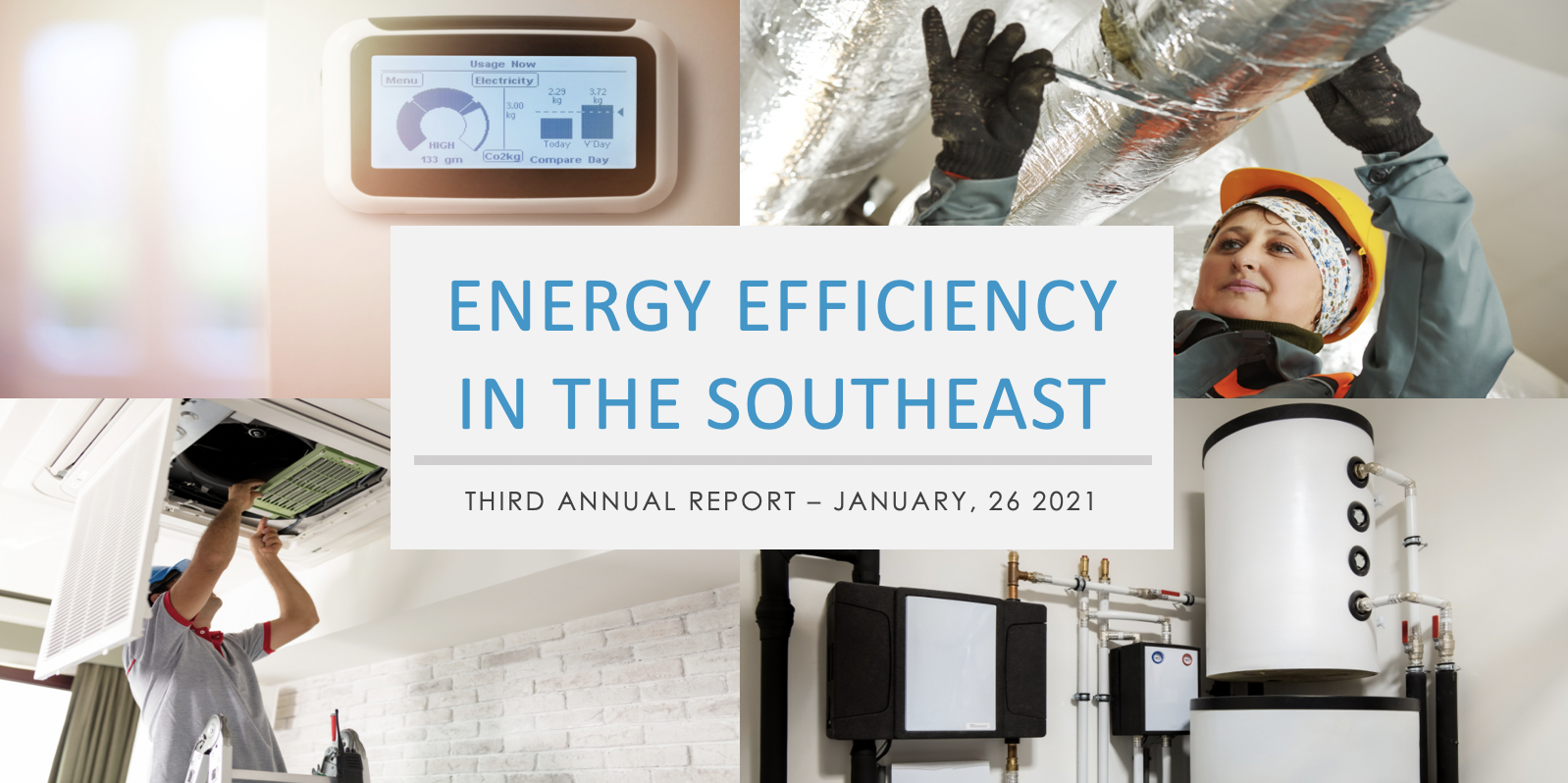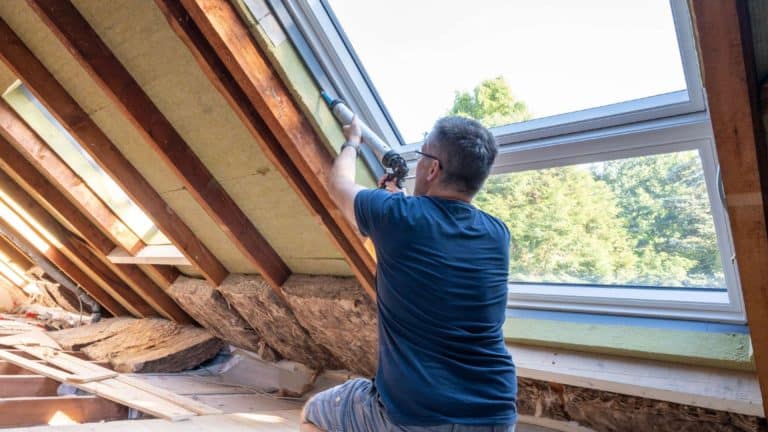Each year SACE compiles efficiency performance data from nearly 500 electric utilities in the Southeast, which we now present in our third annual “Energy Efficiency in the Southeast” report.
Our analysis reveals that nearly three-quarters of the region’s total energy efficiency savings come from just three companies: Duke Energy Carolinas (DEC), Duke Energy Progress (DEP), and Georgia Power.
Energy efficiency is a low-cost, clean energy resource that reduces energy waste and carbon emissions while lowering customer bills. But too many utilities, including some of the Southeast’s largest, fail to serve the efficiency needs of their customers and instead continue to over-rely on outdated fossil fuel generation.
Our latest report centers on utility efficiency savings from 2019 (the most recent year with complete data) taken as a percent of the prior year’s retail sales – which creates a standard metric to compare performance between utilities and states of different sizes. Our data findings are presented with both historical context and the most recent policy trends to give a sense of where efficiency savings performance will likely go in coming years.
Since the data used for this report comes from 2019, it does not include annual efficiency performance stats from the COVID-19 pandemic, but we do provide insights on how efficiency programs have been impacted and what to look for in next year’s report.
[button color=”blue” url=”https://bit.ly/seeereport21″]Download the Report[/button]
[button color=”blue” url=”https://cleanenergy.org/?s=SEEnergyEfficiencyReport2021″]Read the Report Series[/button]
[button color=”blue” url=”https://cleanenergy.org/news-and-resources/energy-efficiency-in-the-southeast-third-annual-report-webinar/”]Watch the report webinar[/button]
Duke in the Carolinas Leads the Southeast
In 2019, Duke Energy Carolinas and Duke Energy Progress continued to lead our region in percent annual efficiency savings and were the only Southeast utilities to top the national average. Georgia Power and Tampa Electric exceeded the Southeast regional average, but this is far below the rest of the nation. By contrast, average savings in the Northeast are more than five times higher than in the Southeast.
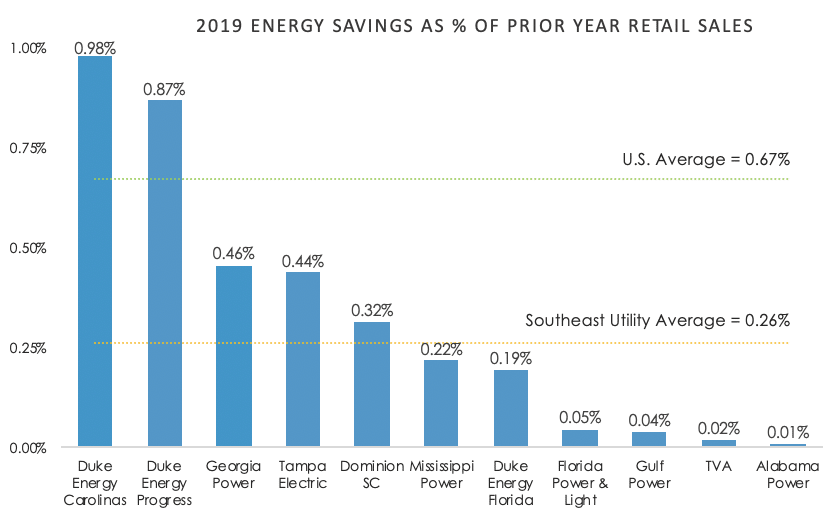
TVA Dragging the Regional Average Downward
The Southeast’s other major utility systems are badly underperforming, and overall savings in the region fell from the previous year. This is largely the result of the Tennessee Valley Authority’s (TVA) recent near-total abandonment of energy efficiency, causing it to fall from the middle of the pack a few years ago to second to last today. Because TVA is such a large utility, responsible for 19% of all electric sales in the region, its decline to a mere 1% annual efficiency savings has had the effect of dragging down the Southeast regional average as a whole.
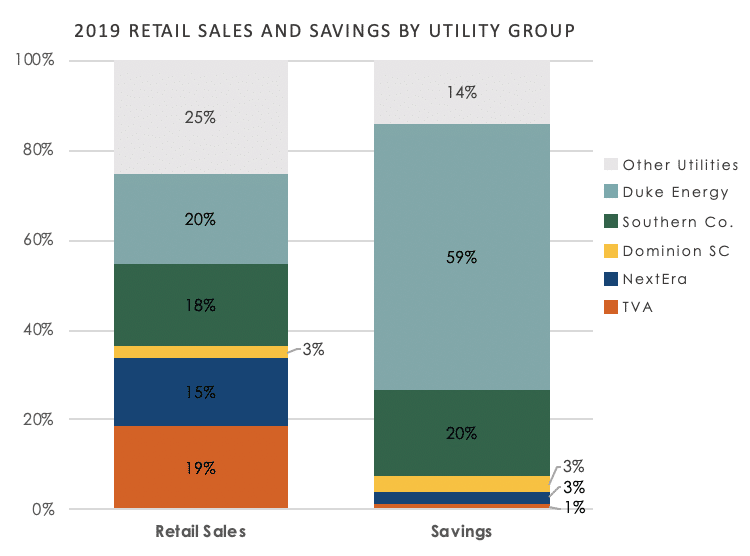
How do Southern States Stack Up?
Duke Energy kept North Carolina at the top of regional performance, but in 2019 the state fell just shy of the national average. South Carolina and Georgia trailed far behind, but nevertheless surpassed the much lower regional average. By contrast, outdated efficiency policies in Florida have kept the country’s third most populous state near the bottom of national rankings (and weighted down the regional average), while residents of Tennessee and Alabama receive virtually no utility efficiency savings at all.
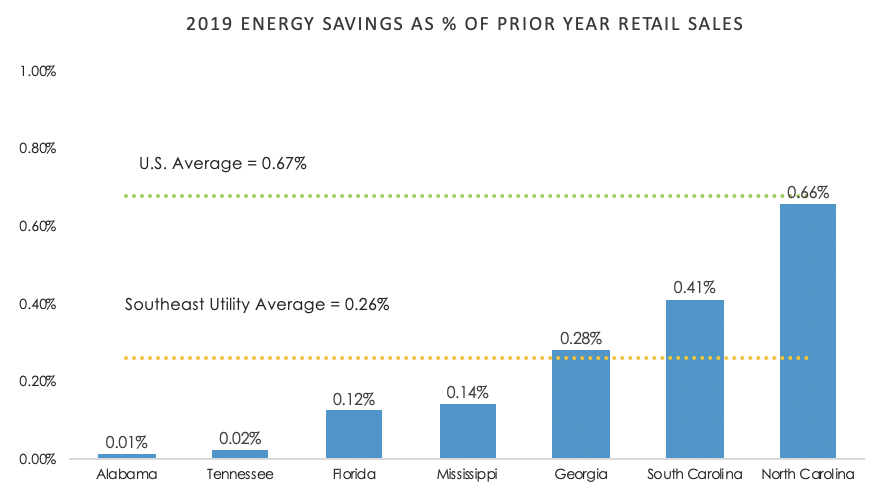
Reforming Florida’s Outdated Efficiency Rules
Florida is one of the country’s lowest-performing states for utility efficiency — its outdated efficiency policies haven’t been updated in over 27 years. A lot has changed since 1993 when most people had never even heard of, much less used, the internet. Since then, efficiency mainstays like LED lights, heat pumps, and smart thermostats have all gone mainstream, while the state’s outdated policies have fallen ever farther behind the times.

Fortunately, the Florida Commission recently opened a rulemaking process that will be one of the most important developments to watch in 2021. Because Florida is by far the largest state in the Southeast, modernizing Florida’s Energy Efficiency Conservation Act (FEECA) rules could also have far-reaching implications for the region as a whole.
Efficiency During the COVID-19 Pandemic
In 2020, COVID-19 fundamentally disrupted efficiency programs in the Southeast, while intensifying energy insecurity for millions of already-vulnerable households.
As usual, there was a clear divide between responses from the region’s utilities – along with the age-old tension between customer needs and utility profits. Some utilities prioritized overcoming challenges to serve customer efficiency needs during the pandemic, while others drastically reduced efficiency program operations. Utilities that pivoted to resume program operations with new safety protocols in place, like Duke’s utilities in the Carolinas, are expected to meet their projected 2020 annual savings targets, while Georgia Power and others are likely to fall far short of their required savings goals.
Early in the pandemic, moratoriums on utility disconnection provided vital short-term protection for customers. But when the moratoriums ended, the bills came due for millions of families across the Southeast – and some utilities are now cutting off power for some of our region’s most financially vulnerable households. Under these extraordinary circumstances, it is critical utilities suspend disconnections throughout the crisis, waive late payment fees, reconnect customers that have been recently been disconnected due to nonpayment, and commit to investing in bill-lowering measures like energy efficiency and solar energy.
Instead of expanding efficiency programs to help customers afford their new and past-due payments, many utilities appear to be looking for regulatory bailouts to cover uncollected bills, which inevitably means passing the costs on to all customers in the form of higher rates. Outside the region, Arizona provides an example of regulators and utilities expanding efficiency services to low-income customers in response to the pandemic – but there has been little progress on similar efforts in the Southeast.
There is a better solution for households facing the downward spiral of unaffordable energy costs – one that pairs targeted efficiency program services with repayment plans and some degree of debt forgiveness. This is a more humane approach to meet customer needs, and reduce costs that would otherwise be shouldered by other customers.
Utilities Should Plan for More Efficiency
Resource planning requirements across our region are quickly evolving. With representation by the Southern Environmental Law Center, SACE was one of several parties to formally intervene in the 2020 Dominion Energy Integrated Resource Plan (IRP) docket in pursuit of greater transparency and fair competition between clean energy resources and fossil fuel generation. In a dramatic recent decision, the South Carolina Public Service Commission (PSC) invoked the Energy Freedom Act of 2019 to reject Dominion’s 2020 IRP. The Commission’s December Order requires the company to go back to the drawing board and resubmit its plan with substantially more solar and energy efficiency resources (at least 1% annual savings). Ahead of future IRP cycles, Dominion is also required to “evaluate realistic options to achieve greater energy savings and model a high [demand side management] DSM scenario in the 2023 IRP.” SACE will continue to stay involved in this important process moving forward.
Similarly, Duke Energy is now subject to new IRP requirements from both Carolina Commissions, with decisions expected later this year. Changes in IRP practices are also taking shape in Mississippi and Georgia, and Florida may be next. In each of these cases, greater transparency and competition between supply-side and demand-side energy resources could provide a boost to energy efficiency in the Southeast, as they have in other regions.
Only time will tell if these changes will take hold and lead to more realized savings for families and businesses in the Southeast.
Efficiency and the Clean Energy Transition
It is no coincidence the Southeast has among the highest electricity bills in the country and the lowest investment in energy efficiency. It’s time we turned this around. Energy efficiency is a clear solution for lower bills, economic recovery, and addressing the threat of climate change.
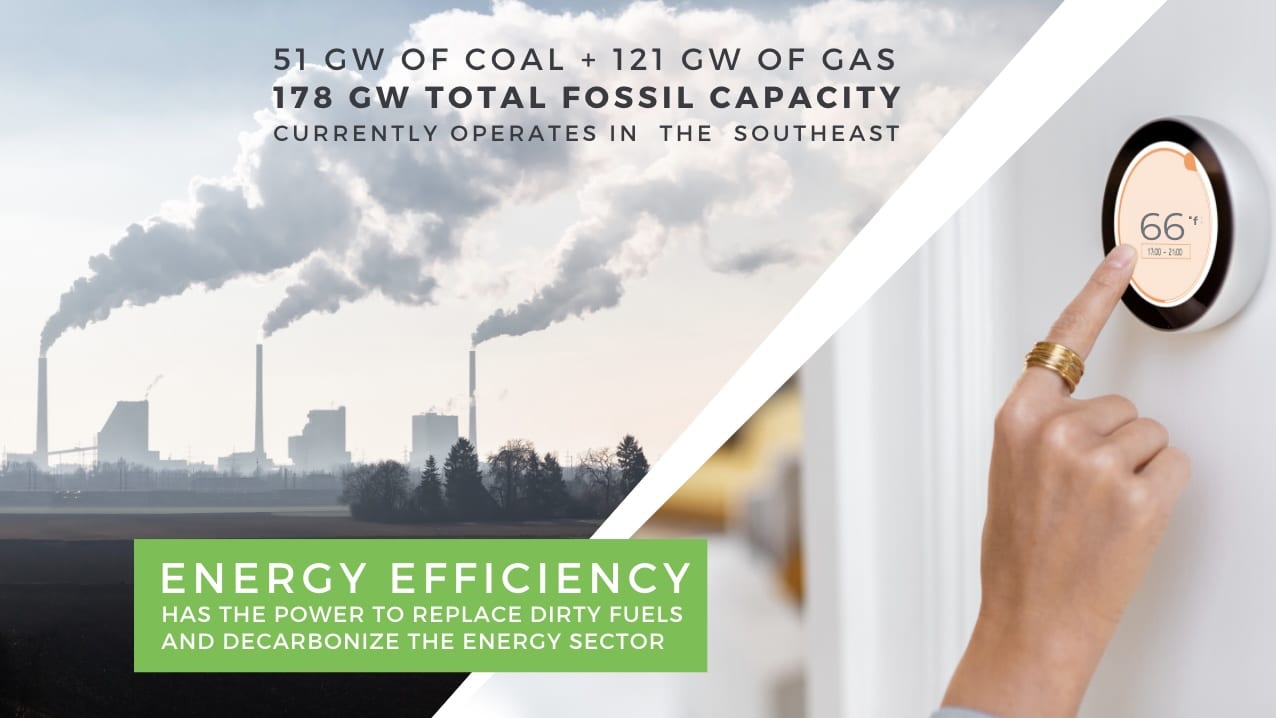
The Biden administration has promised action on climate change, including investment in energy efficiency. No utility is better matched for this opportunity than the federally-owned Tennessee Valley Authority (TVA). Innovation in energy efficiency at TVA could usher in a new era for its customers and create a new clean energy utility model for the rest of the nation to follow.
The United States cannot truly achieve a clean energy transition without the Southeast. Retiring expensive and dirty fossil fuel power plants is critical, but the current rush by many utilities to replace them with new fossil gas generation perpetuates environmental injustices and risks squandering billions of customer dollars.
The path to a cleaner, more equitable, more affordable energy future is renewable energy and energy efficiency. Investments in energy efficiency, renewables, and electric transportation are proven to generate good, local jobs; and as we recover from the COVID-19 pandemic and intensify our fight against the climate crisis, significant investment in energy efficiency will put thousands of people back to work, free up extra dollars in family budgets, and reduce the existential risk of climate change. At this point in history, we haven’t a moment to lose.
[button color=”blue” url=”https://bit.ly/seeereport21″]Download the Report[/button]
[button color=”blue” url=”https://cleanenergy.org/?s=SEEnergyEfficiencyReport2021″]Read the Report Series[/button]
[button color=”blue” url=”https://cleanenergy.org/news-and-resources/energy-efficiency-in-the-southeast-third-annual-report-webinar/”]Watch the report webinar[/button]
Stay tuned for more blog posts in our upcoming series going deeper into the report results.
#SEEnergyEfficiencyReport2021
